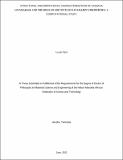| dc.description.abstract | Linamarase and linamarin mainly from cassava have many applications ranging from food,
environmental to the medical industry. To better explore the potential of this enzyme and its
substrate, one needs to understand its interaction mechanism at the molecular and atomistic level.
In this thesis, the three‒dimensional (3D) structure of linamarase was built via homology
modeling. The developed model was used to determine the binding orientation and mechanism of
linamarin to the enzyme using molecular docking. Molecular dynamics simulation was used to
determine the stability of the built model and when complexed with the ligand. It was interesting
to note that complex 1 with the low binding‒free energy of ‒6.9 kcal/mol showed a larger Root
Mean Square Deviation (RMSD) value with two maxima at 0.255 and 0.310 nm compared to
complex 2 with the best binding‒free energy of ‒7.2 kcal/mol, whose RMSD value shows the
maxima at 0.19 nm. The end‒point free energy method based on Molecular Mechanics Poisson
Boltzmann Surface Area (MM/PBSA) was used to rescored binding free energy obtained from
docking calculations. The ensemble structure was observed to be relatively stable compared to the
modelled structure. Furthermore, the stability and conformational orientation preferences of
linamarin in different solvents was established using classical molecular dynamics, and found to
be solvent dependent. The effects of solvents on the stability and conformational preference is
pronounced by different probability density maxima of the measured reaction
coordinate/properties. Linamarin is observed to be stable in methanol followed by dimethyl
sulfoxide (DMSO) and least stable in water. Solvent polarity was observed to influence the
stability and conformation preference of the title compound. Linamarin exists in trans and gauche
conformations, the former was observed to be more stable in water than other solvents and the
latter in DMSO. The measured reaction coordinates, distance and dihedral angles ascertained that
the conformational preference is due to rotation at 𝜙 = ± 180o
and 𝜙 = ± 50o . Finally, the stability
of linamarin was also attributed to different numbers of inter and intra hydrogen bonds formed in
different solvents. Results presented in this thesis provides atomistic insights on the role of solvents
polarity on linamarase‒linamarin complex interaction and stability. The findings provide
important information on the application of linamarase and linamarin in different fields including
food processing and in drugs. | en_US |

